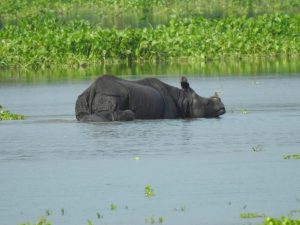India’s northeastern state of Assam has been devastated by floods, leaving behind a trail of destruction. Seven people, including two children, have died so far.
Incessant rains in Assam and parts of Arunachal Pradesh over the past few days caused the water level of the Brahmaputra river and its tributaries to rise. The rivers are flowing above the “danger level” mark in several places.
As many as 22 of Assam’s 34 districts have been impacted by the flood waters. Over 4,000 are displaced and they are being lodged at relief centers. More than 1,300 villages have been submerged and 395 square kilometers of crops damaged by the deluge that has ravaged Assam for over two weeks.
A media statement issued by the Assam State Disaster Management Authority (ASDMA) on September 2 said that there is a slight improvement in the situation with a decrease in the total number of affected people which was close to half a million people. The three districts of Nalbari, Lakhimpur and Darrang are the worst-affected, the ASDMA said, adding that the government has stepped up relief operations among those affected by the floods.
The Kaziranga National Park in eastern Assam, which is spread over an area of 430 sq km, has been inundated, resulting in the death of at least 13 animals. The government has stopped movement of vehicles through the park. The park, which is known for its rhino population is also a tiger reserve, and one of two World Heritage Sites in the state.
In the last seven decades, Assam has been devastated by floods periodically. These floods are triggered by a combination of natural and man-made factors, including the rise in the bed of the Brahmaputra due to siltation, unstable nature of the river, breach of embankments and frequent release of water from the hydel dams located in Arunachal Pradesh, Nagaland and Bhutan.
According to a report compiled by the Assam government, the state loses 2,000 million rupees on average annually on account of floods. According to the National Commission on Floods, of Assam’s 78,523 sq km of land, 31,050 sq km is flood-prone. In other words, 39.58 percent of Assam is prone to flooding. This is 9.40 percent of India’s total flood-prone area.
Associated with flooding is the problem of river bank erosion. This is particularly severe in Assam’s Brahmaputra valley and has led to the loss of more than 4,000 sq km of land since 1950, which is 7.40 percent of area of the state. Erosion has resulted in the expansion of the width of the Brahmaputra. This river is around 15 km wide at some places in the state.
For the government, tackling flood and erosion has meant a predictable replay of actions and policies every year – repair of embankments, arranging funds and occasionally briefing the media on the controversies that erupt over the allocation and implementation of the schemes.
A few months ago just ahead of the assembly elections in Assam, Union Home Minister Amit Shah came up with the idea of diverting the waters of the Brahmaputra.
While delivering a speech at a public rally in the river island of Majuli, which is one of the most flood-prone areas in the state, Shah said that the government would build “large water reservoirs and water channels to divert the floodwaters of Brahmaputra and use it for irrigation and to give relief to the people of the state from the floods.”
Nothing has been heard about this plan since.
The increase in population and encroachments in Assam has worsened the problems of the state during floods. The central government has therefore decided to set up the North East Water Management Authority (NEWMA) to facilitate a coordinated approach to check the twin dangers in the region. The new agency will replace the Brahmaputra Board which was set up in 1982 for the same purpose.
Meanwhile, the Brahmaputra Board has already begun implementing new schemes to check flood and erosion. These projects are different from the ones implemented by the previous government in the state. The new strategy focuses on “soft measures” such as planting of certain categories of grass on the river banks that are prone to erosion.
Hard measures like engineering structures would continue alongside the soft measures that are to be executed as part of the new approach by the Brahmaputra Board. Ten new master plans are being designed for the projects and some earlier ones revised with new data, which would also take into account the impact of climate change in India’s northeastern region.

































